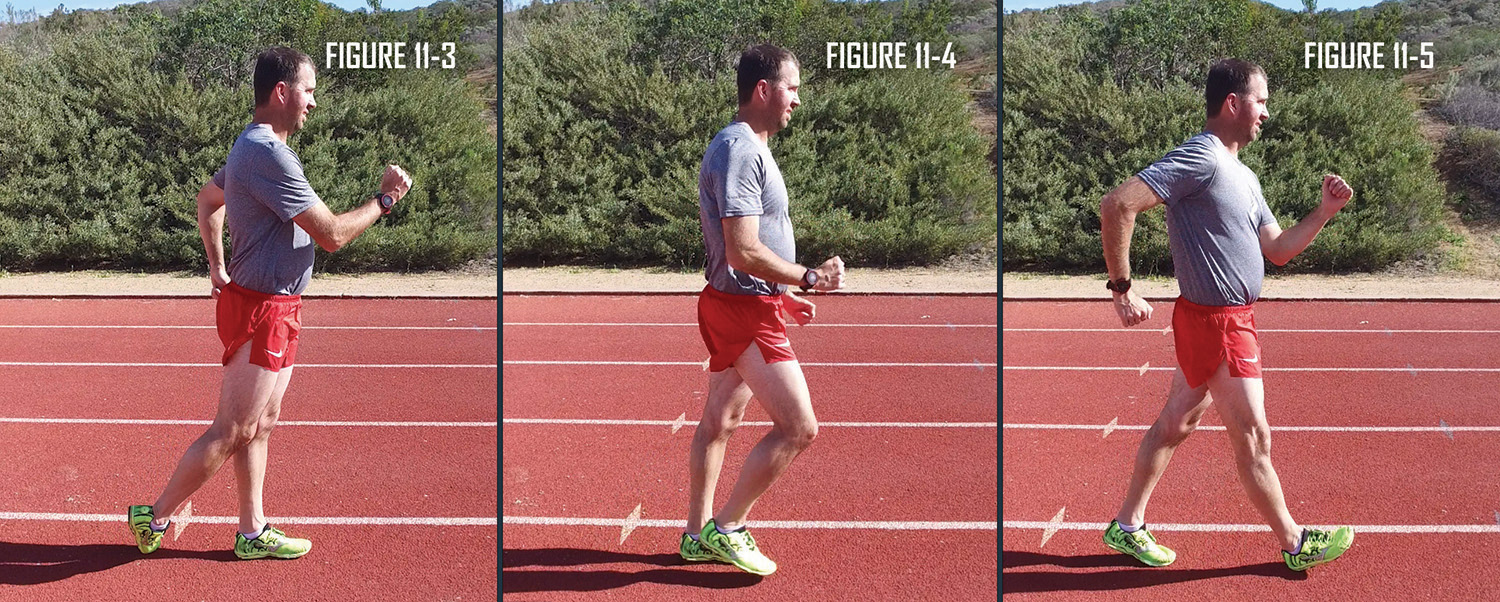
Walking with a high knee drive is fraught with problems. While you may be walking with one foot in contact with the ground at all times, a high knee drive may make you appear to lose contact. Even if you are not getting disqualified, you still need to be concerned about wasted energy by moving your leg up and down further than necessary. The leg is approximately 15 to 20 percent of the body’s weight. Lifting it higher than necessary, approximately 20,000 times during a 20km race, wastes a lot of energy. Additionally, a high knee drive, gives you the appearance of running instead of having a fluid movement. Your head may also bounce up and down, creating an added jarring motion in your stride and potentially increasing your chance of injury.


Instead of driving your leg forward with the top of your leg leading the way, once the knee passes under the torso focus on swinging the lower leg and foot as fast as possible until your heel strikes the ground.

One method to get your knees lower is to think of your swinging foot like a broom, sweeping as low to the ground as possible. Studies have shown that the higher the foot is swinging through the stride, the more likely the athlete is to get loss of contact violations.

While it may sound obvious, to prevent a high knee drive, focus on keeping your knee low. When the leg swings forward and the knee drives upwards, it gives the appearance of loss of contact.

By dragging your foot along the ground, you are training your body not to drive the knee high. Once the body is accustomed to walking with low foot carriage, you can raise the foot slightly and will be race walking with improved knee drive.
Body Position
Stand as you would when you are race walking.Steps
- Walk slowly, swinging the foot so low that you scuff your toes on the ground as they move forward.
- Do this for 30 to 50 meters. Do not scuff your feet for an entire lap or through a full workout.


The first 10% of the stride is most important. It’s what helps differentiate a race walker from a speed or health walker. It focuses on heel strike with the toe pointed up. We call it the Foot Plant drill and you must master it before progressing forward.
Steps
- Start by standing with your weight on your rear foot (Figure 3-3).
- Swing your other leg forward (Figure 3-4) from the knee until it fully extends.
- As you do, land with your foot slightly in front of the body, with your toes up and the knee straightened (Figure 3-5).
- Transfer all your weight to that leg (Figure 3-6).
- While virtually standing in place, rock back and forth from one foot to the other emphasizing the heel strike.
- Note that the knee does bend when you rock back.
- Repeat this exercise for both legs.


The Hip Flexor – Lunge Forward stretch is great for working on tight hip flexors which inhibit proper forward hip rotation.
Body Position
Place your right knee on the ground with your right foot extended behind you. Place your left foot on the ground in front of you, making sure the left knee stays behind the ankle.
Steps
- With a straight back, lunge forward and feel the stretch in your right hip flexor (Figures 9-10 & 9-11).
- Hold for 20-30 seconds.
- Repeat 2-3 times on each side.
- For an advanced stretch, raise both your hands while keeping your back in a vertical position (Figure 9-12).


Tight hip flexors inhibit proper forward hip rotation.
Body Position
Kneel on the ground, preferably soft ground.
Steps
- Place your left leg in front of the body while bending at the knee.
- Lower your torso, using your hands for support.
- Slide the right leg back and lower your torso all the way down so that your forearms are supporting your body weight.
- Feel the stretch across your right hip flexor and left piriformis.
- Hold for 20-30 seconds.
- Repeat 2-3 times for each side.
